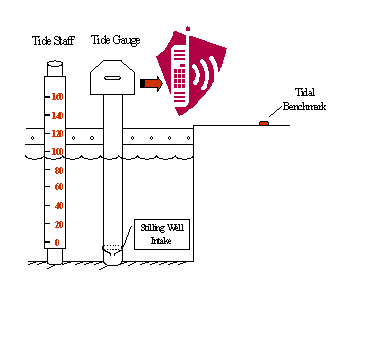Water Level Measurement
 The measurement of tides is
not quite direct. You’d think that an instrument called a tide gauge
(tide gage) would do just that – measure tides. But, as
shown in the tide analysis module, the water level change that finds its way
into a tide gauge record contains more than the astronomical tide alone (storm
surge, for example). For that reason, the initial data recorded are really
water level measurements – the tides come later! It’s also necessary to
recognize that a tide gauge, an instrument that automatically records water
levels at fixed intervals of time, is only one part of a tide station. The statement needs emphasis because it’s
surprisingly easy to produce bad water level records and no one is likely to be
more aware of that than the person who subsequently tries to analyze and make
use of them to figure out the tide. Here are the components that every station requires.
The measurement of tides is
not quite direct. You’d think that an instrument called a tide gauge
(tide gage) would do just that – measure tides. But, as
shown in the tide analysis module, the water level change that finds its way
into a tide gauge record contains more than the astronomical tide alone (storm
surge, for example). For that reason, the initial data recorded are really
water level measurements – the tides come later! It’s also necessary to
recognize that a tide gauge, an instrument that automatically records water
levels at fixed intervals of time, is only one part of a tide station. The statement needs emphasis because it’s
surprisingly easy to produce bad water level records and no one is likely to be
more aware of that than the person who subsequently tries to analyze and make
use of them to figure out the tide. Here are the components that every station requires.
Tide Staff – A tide staff graduated in feet or centimeters is installed in a permanent housing mounted next to the tide gauge. After installation, the zero mark on the staff becomes the vertical reference (the station datum) that all subsequently recorded water levels refer to.
Tidal Bench Mark – Should anything happen to the staff, a permanent mark such as a brass disc set in concrete prevents the loss of the station datum (tide staff zero) after a leveling survey between the mark and the staff. This is especially important at stations where the calculation or transfer of a tidal datum, such as mean high water or mean low water, is required.
Tide Gauge – Mechanical devices for recording water level are still in use but these are mostly being replaced by acoustic water level meters that measure and record data electronically. The data can even be transmitted by cell phone! Unlike the mechanical gauge that featured a spring-loaded pulley and wire leading down to a cylindrical float inside a vertical stilling well, the acoustic devices utilize an acoustic “shock-wave” sent down a vertical wave-guide. After striking the water surface, the wave is reflected back to a transducer and microcomputer that converts travel time to distance based on the speed of sound in air. While acoustic instruments don’t have moving parts to jam or become fouled, they do require compensation for the effects of temperature change on sound speed to maintain their high standard of accuracy.
Of course, any gauge needs to be monitored frequently to avoid “systematic” errors in the time or height recorded. Just as the correct time must be set on the clock mechanism, the water level indicator must be set to agree with the actual reading on the tide staff. This is a kind of hierarchical insurance; the staff is insurance against gauge disturbance or malfunction and the benchmark (or several benchmarks) is insurance against damage to the staff. Without this insurance, water level readings have no protection against the “floating datum” syndrome.
Tide Gauge? Or Wave Gauge? Although all tides are waves, not all waves are tides. Wind waves with periods on the order of seconds have no place in water level records at a tide station and neither do transient waves due to boat or ship wakes, both of which are likely to cause serious data contamination problems unless prevented from doing so. This is the job of the stilling well, a device specifically designed to admit only low-frequency oscillations in water level inside the sensing environment – a tube or pipe of fixed inside diameter. The bottom of the tube is usually sealed except for a single small orifice that limits the rate at which water can enter or exit the tube. In some designs, a plastic, funnel-shaped coupling joining two tube sections allows a spiked tool to be lowered into the orifice opening for periodic cleaning.

